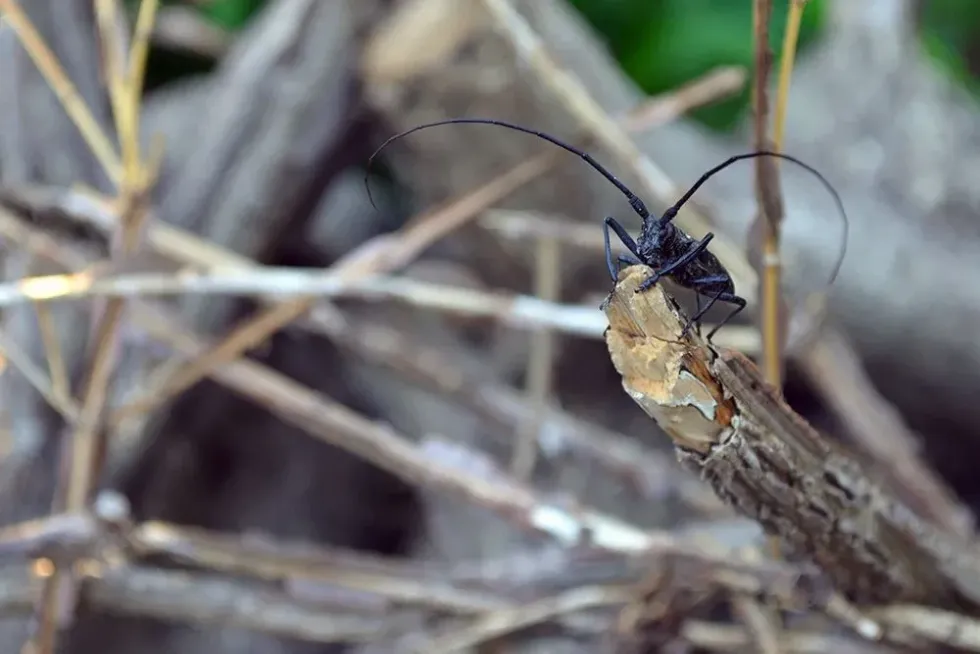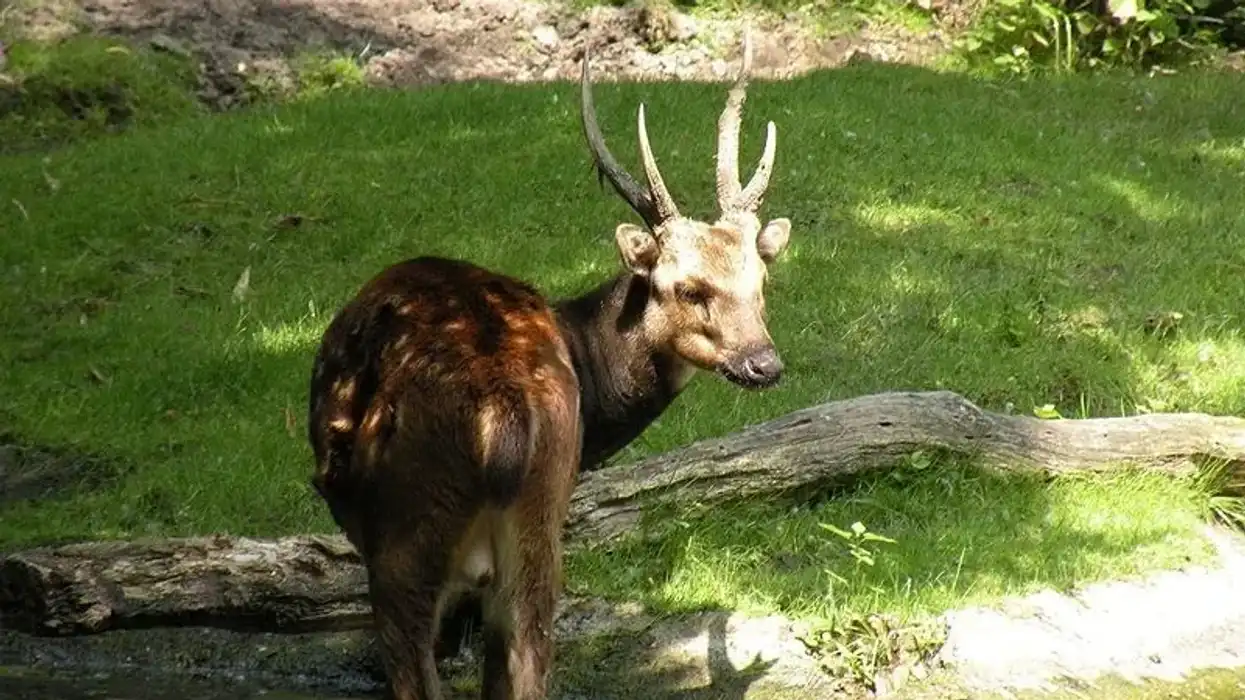White-spotted sawyer beetle (Monochamus scutellatus), also known as a spruce bug, spruce sawyer, or white-spotted sawyer, is a species of common-wood-boring beetle of the family Cerambycidae. There are two recognized subspecies of this beetle, Monochamus scutellatus scutellatus and Monochamus scutellatus oregonensis.
Beetles of the genus Monochamus have a wide range of habitats across the world. These species are called sawyers or sawyer beetles. They are named so because sawyer beetle larvae bore into dying trees, particularly coniferous specimens like pine trees.
The type genus of these beetle insects is Monochamini, a tribe in the Lamiinae subfamily. However, they are traditionally a part of the Lamiini tribe.
There are over 100 species in this genus. The white-spotted sawyer beetle belongs to the Lamiinae subfamily of flat-faced longhorns, which includes more than 750 genera. Adult white-spotted sawyers are black-colored.
These beetle insects are native species of North America. These species can cause a 30-40% loss in value of freshly cut pine logs due to the larvae bored tunnels.
If you enjoyed these facts, then do check out the green June beetle and hister beetle to learn more amazing facts.
White-Spotted Sawyer Beetle Interesting Facts
What type of animal is a white-spotted sawyer beetle?
The white-spotted sawyer is a common-wood-boring beetle species of the order Coleoptera and phylum Arthropoda.
Research shows that many Monochamus beetles use bark beetles' pheromones as kairomones to find their host habitats efficiently, which allows them to save time and energy for other activities.
The presence and life cycle of the white-spotted beetle insects are related to the intensity of the fire, the distance between unburned and burned land, and the size of burned trees.
Most research on the white sawyer spotted beetle is related to their connection with the logging industry, burned forests, and also mating behavior.
What class of animal does a white-spotted sawyer beetle belong to?
The white-spotted sawyer belongs to the class insects of animals.
How many white-spotted sawyer beetles are there in the world?
The exact number of the white-spotted sawyer beetle in the world is not known. Like all the other beetle insects, these species, too, are spread around the world.
Where does a white-spotted sawyer beetle live?
The white-spotted pine sawyer beetle is native to North America. They occupy a range of Mexican, United States, and Canadian forests.
What is a white-spotted sawyer beetle's habitat?
The range of white-spotted sawyer beetle habitat extends in boreal forests, spruce forests, balsam fir, eastern white pine, and pine forests. A part of their life cycle is dependent on dying or dead trees, wood, and logs.
Who do white-spotted sawyer beetles live with?
Like other beetle insects, these sawyer adult beetles, too, live and migrate in groups.
How long does a white-spotted sawyer beetle live?
The life cycle of adult beetles is for one to two years.
How do they reproduce?
Monochamus scutellatus compete with both interspecies and intraspecies over resources. Experiments were conducted by Hughes and Hughes to test the asymmetric contest between Northeastern pine sawyer (Monochamus notatus) and M. scutellatus.
It was found that white-spotted sawyer females laid their eggs and the males with whom they form a pair-bond fertilizes it, and once the pair bonds, the certainty of paternity also decreases. Therefore, males compete over females as they are a valuable resource.
Between female beetle insects of intraspecies and interspecies, the competition was for oviposition holes.
White-spotted sawyer females spend about 20 minutes chewing out oviposition holes in the bark of trees with their mandibles, which produces a loud noise and puts them at risk of detection by predators. So, instead of chewing out holes in the bark, they steal holes chewed out by other females.
A study showed that the large resource holders won against small challengers in a contest for resources. However, between large challengers and small resource holders, this competition escalated to fighting and biting of antennae and legs.
These species have a polygyny mating system so. Males defend all resources needed by females for reproduction.
Females prefer large-diameter basal trunk regions. Also, she chooses her mate based on resources, and when resources are equal, they choose larger males.
Females chew out egg niches into the dead or dying trees or logs and deposit one egg each.
Females lay an average of 15 - 20 white-spotted sawyer beetle eggs per lifetime. After the larvae hatch, they burrow into phloem and tunnel into the cambium of bark in a tree and continue feeding until they emerge.
Adults chew out of the bark hosts around a week after pupation after summer in mid-June or mid-August. Even though they are in the summer, egg slits are cut on the bottom and sides facing away from the sun.
What is their conservation status?
The conservation status of the white-spotted sawyer beetle insect is listed as Not Evaluated.
White-Spotted Sawyer Beetle Fun Facts
What do white-spotted sawyer beetles look like?
Adults have a large black body, and males have long antennae, which can grow up to twice their body length, and in female insects, antennae are slightly bigger than their body. There is a white spot on the base of the wing and sometimes on the wing covers.
These covers have a uniformly rough texture, and the spots are more speckled. There is a spine on the side of the prothorax. The larvae have reddish-brown heads and creamy-white bodies.
How cute are they?
These longhorned North American beetle insects are completely black and like most adult beetle insects they are not considered cute.
How do they communicate?
The white-spotted sawyer beetle sound is similar to a sawyer at work for which they are named. These insects also communicate through the defense, chemicals, and pheromones.
How big is a white-spotted sawyer beetle?
These beetles are 0.7-0.98 in (18-25 mm) in length. The larvae size is 1.57-1.96 in (40-50 mm) length. These species are 17 times larger in size than a fungus beetle.
How fast can white-spotted sawyer beetles move?
The exact speed of this insect is not yet known.
How much does a white-spotted sawyer beetle weigh?
The weight of this white-spotted insect has not yet been calculated.
What are the male and female names of the species?
There is no specific name given to the female and male pine sawyer beetle species.
What would you call a baby white-spotted sawyer beetle?
There is no specific name given to the baby pine sawyer beetle species.
What do they eat?
The adult mainly feeds on the soft bark of conifer branches, and tissue of damaged coniferous species. The adult longhorned insect hosts on eastern white pine, twigs,
Are they dangerous?
No, they are not dangerous or bad. Also, the adult white-spotted sawyer beetle damage does not severely affect the trees.
Would they make a good pet?
No, they would make a good pet. These longhorned beetles thrive in forests typically in a dying or a dead tree.
Did you know...
Both white-spotted beetle and bark beetle adults are incapable of surviving on any healthy tree. The
The white-spotted sawyer beetle family of longhorned beetle faces a threat of deforestation.
The white-spotted sawyer beetle order Coleoptera has over 300 beetles that are used as food, particularly the larvae.
Some predators of these beetles are snakes, wasps, and flies.
Do white-spotted sawyer beetles bite?
Yes, the white-spotted sawyer beetle can bite. Their strong mandibles or mouthparts allow them to cut through wood and dead trees. The white-spotted sawyer beetle bite is very painful and they can even draw out your blood.
How to get rid of white-spotted sawyer beetles?
One of the measures that must be taken is to reduce dying or dead trees. Also, after cutting the logs, placing them in the sun or debarking them would prevent an infestation.
If there is an infestation you can destroy any dead or stressed trees around your house. You can also mulch or chip off the tree but burning is more efficient.
This needs to be done before summer. You can immerse logs in the pond and keep praying the log surface with water. You must strip off the bark in the logs if you want to store them.
Store logs tight and compact woodpiles to prevent infestation growth. Even if these insects infest the logs, this storage method will prevent them to bottom the woodpile.
Here at Kidadl, we have carefully created lots of interesting family-friendly animal facts for everyone to discover! For more relatable content, check out these water beetle facts and Atlas beetle facts pages.
You can even occupy yourself at home by coloring on one of our free printable White-Spotted Sawyer Beetle coloring pages.










